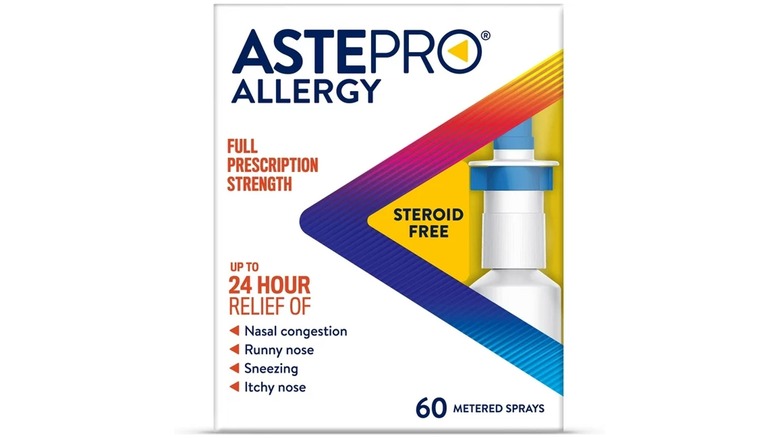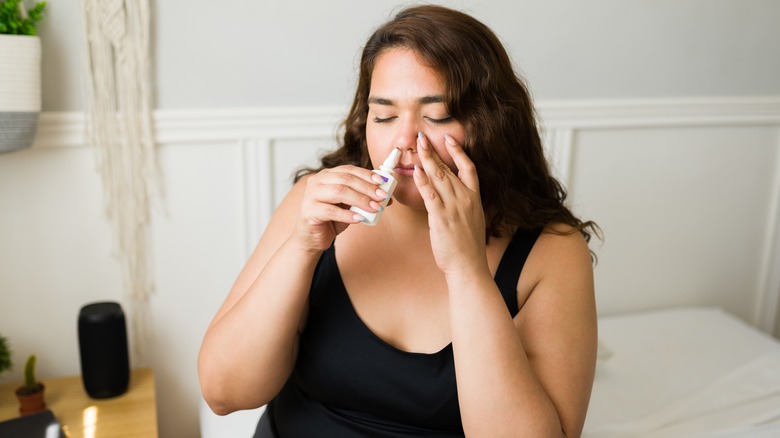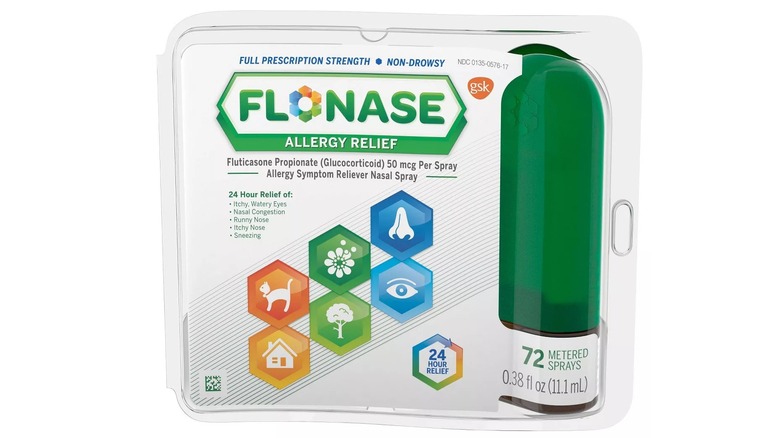Astepro Commercial Explained: Drug Uses, Side Effects, And More
We may receive a commission on purchases made from links.
Commercials featuring our favorite stars never fail to catch viewers' attention. If your eyes were glued to the screen while watching season 2 of HBO's hit series "White Lotus," you likely noticed that one of the main characters recently appeared in an Astepro Allergy commercial. The 30-second spot features actress Meghann Fahy descending an elegant staircase in a floor-length gown, stating how Astepro Allergy can get allergy sufferers back to feeling sexy again.
Data from the U.S. Centers for Disease Control and Prevention (CDC) show that in 2021, over 25% of American adults reported experiencing seasonal allergies. The Astepro Allergy commercial highlights the drug's ability to offer fast-acting symptom relief, which may have left those affected by seasonal allergies wanting to learn more. Because the medicine can be purchased over-the-counter (OTC), the ad didn't feature a list of possible side effects or precautions. However, it's important to be aware of how a drug works even when a prescription isn't required. Here, we've outlined what Astepro Allergy can be used for, potential adverse effects, and more.
What is Astepro Allergy and what does it do?
Manufactured by Bayer, the company states that what separates Astepro Allergy from its competitors is that it's the only steroid-free, prescription-strength OTC nasal spray that starts working 30 minutes after the first dose rather than taking hours to kick in. As an antihistamine, the medicine is designed to relieve common allergy symptoms for a period of 24 hours, such as sneezing, itchy nose, nasal congestion, and runny nose. The active ingredient in Astepro Allergy that blocks the body's release of histamine is azelastine hydrochloride [ a-ZEL-uh-steen ] — 205.5 micrograms (mcg) of which can be found in each spray. The medicine also contains sucralose and sorbitol to sweeten the taste of the spray.
The drug is approved for adults and children at least 6 years of age to be used one to two times daily. Kids ages 6 through 11, however, should not use the product without adult supervision. The drug should not be used by children younger than 6 years old. While Astepro Allergy can be purchased over-the-counter, GoodRx Health notes that the generic version of the drug – azelastine nasal spray – can alternatively be obtained with a doctor's prescription.
Astepro Allergy side effects
Per its FAQ, one of the most commonly asked questions about Astepro Allergy is whether it can cause consumers to feel drowsy. Clinical trials revealed that drowsiness was a side effect identified in fewer than 4% of patients using the drug. For this reason, a warning has been issued on the product drug label, which cautions consumers about using Astepro Allergy while operating machinery or an automobile. Use of tranquilizers, sedatives, and alcohol can further exacerbate drowsiness. As such, consumers are advised to avoid alcohol consumption altogether when taking Astepro Allergy.
Additional side effects may include temporary nasal discomfort or sneezing after administering the medication intranasally. Patients may also experience a bitter taste in the mouth. However, the company notes that clinical trials revealed more than 90% of Astepro Allergy users did not experience a bitter taste. Users are advised to stop using the nasal spray and to contact their physician if they experience a skin rash or any other symptoms of an allergic reaction to the medication or if they develop severe or recurring nosebleeds. See the Astepro Allergy drug label for all information regarding warnings, uses, and directions.
Astepro Allergy dosage
For adults and children at least 12 years of age, Astepro Allergy should only be used once or twice a day. For once-daily users, administer two sprays in each nostril. For twice-daily users, administer one or two sprays per nostril every 12 hours. The maximum number of sprays issued over a 24-hour period should not exceed four per nostril. Children ages 6 through 11 should only receive one spray per nostril every 12 hours and should not receive more than two sprays in each nostril within 24 hours.
Start by taking off the product cap and clip, and aim the bottle away from you. Administer a few preparatory sprays to ensure the bottle isn't clogged. Clear your nostrils by blowing into a tissue, and then tilt your head at a downward angle. This will reduce your chances of experiencing a bitter taste. Hold one nostril closed while inserting the tip of the nozzle about one-quarter inch to one-half inch inside the open nostril. Keeping the bottle upright, lightly sniff while pressing down on the pump. Do the same for the other nostril before wiping off the nozzle and replacing the cap and clip.
As noted on the product label, you'll want to review the User Guide for instructions on what to do if the nozzle becomes clogged or how to prime the bottle if it hasn't been used in at least three days. In the event of an overdose or suspected poisoning, call Poison Control at 1-800-222-1222.
Astepro Allergy precautions
According to Astepro Allergy's Drug Facts label, there are instances in which patients should first check with their healthcare provider before starting the medication. This includes people with recent cases of nose ulcers, nose surgery, or a nose injury that is still in the healing process. Those who are pregnant or breastfeeding are also advised to consult with their doctor beforehand. Astepro Allergy should only be administered in the nose and should not be sprayed in the mouth or eyes. Refrain from sharing the bottle with others, as this increases the risk of germ transfer. Consumers should not use the medication if the "sealed for your protection" labels on the top and bottom of the box are broken or missing. Astepro Allergy is not considered addictive, nor has it been linked with pediatric growth suppression (via its FAQ).
When it comes to drug precautions, it's important to note the difference between Astepro and Astepro Allergy, which are two different medications. As previously referenced, azelastine nasal spray is a prescription-only, generic allergy-relief spray (via GoodRx Health). The brand-name version of azelastine nasal spray is Astepro, which also requires a prescription (via Mayo Clinic). Astepro Allergy, however, does not require a prescription and can be purchased OTC. Inform your doctor if you are diagnosed with kidney disease or any other medical issues prior to taking prescription Astepro, as some health conditions may heighten the drug's effects.
Avoid taking Astepro Allergy if you are on these medications
As previously mentioned, tranquilizers, sedatives, and alcohol may heighten the side effects of drowsiness. Patients should therefore avoid alcohol and exercise caution when driving or operating heavy machinery. Astepro Allergy contains the prescription-strength active ingredient azelastine hydrochloride, as well as several inactive ingredients, including benzalkonium chloride, edetate disodium, hypromellose, purified water, sodium citrate, sorbitol, and sucralose. As highlighted on the Drug Facts label, individuals who have experienced allergic reactions to any of the outlined active or inactive ingredients should not take Astepro Allergy.
While Astepro Allergy is a separate product from prescription Astepro, both contain the same active ingredient. Therefore, it's worth noting that prescription Astepro (azelastine nasal spray) has been linked with some additional drug interactions, such as certain antidepressants, rare muscle condition treatment drugs, Alzheimer's symptom treatment drugs, and some daytime sleepiness treatment medications (via Mayo Clinic).
This includes:
-
Amifampridine
-
Bupropion
-
Donepezil
-
Pitolisant
Talk to your doctor for a full list of all potential drug interactions with either prescription Astepro nasal spray or Astepro Allergy.
How much does Astepro Allergy cost?
Available for purchase at a number of different retail locations, the price of Astepro Allergy may vary depending on where you buy it. According to their store locator feature, a 0.37 fl. oz. bottle of Astepro Allergy containing 60 sprays can be purchased for $14.99 at Walgreens. This appears to be the lowest price at which it can be bought, as the cost goes up slightly from there. The medication is priced at $15.73 at Walmart or $15.99 at either Target or CVS Pharmacy. The highest price listed for Astepro Allergy is $18.99 at Rite Aid.
The medication can also be purchased online through the Astepro Amazon store. A bottle of 60 metered sprays is listed at a price of $14.99. With over 2,000 customer ratings, the product is ranked at 4.1 out of 5 stars. A 1.01 fl. oz. bottle of Astepro Allergy containing 200 metered sprays can also be purchased through their Amazon store for $32.41 as a one-time purchase. Customers can potentially earn anywhere from a 5% to 15% discount on repeat orders.
What's the difference between Astepro Allergy and Flonase nasal spray?
Both Flonase allergy-relief nasal spray and Astepro Allergy work by reducing bothersome symptoms associated with allergies. The difference is that Flonase is a nasal steroid, which works by dampening the body's inflammatory immune system response to an allergen (via GoodRx Health). Other brands of nasal steroids include Nasacort, Nasonex, and Rhinocort. When used every day, these over-the-counter (OTC) drugs may take several weeks to fully kick in. Steroid-free medications like Astepro Allergy differ from Flonase by offering more immediate relief. Astepro Allergy is an antihistamine rather than a nasal steroid. By hindering the release of histamine in the body, symptoms normally prompted by allergen exposure are reduced.
The two medications also differ when it comes to who they are approved for. While Astepro Allergy should not be used by children younger than 6, children as young as 4 can use Flonase nasal spray. Children ages 6 through 11 using Astepro Allergy may receive up to two sprays per nostril in a 24-hour period, while children ages 4 through 11 using Flonase should only receive 1 spray in each nostril in a 24-hour period. There are also some minor differences between the recommended adult doses, so whichever product you choose, always be sure to read the product label carefully.







